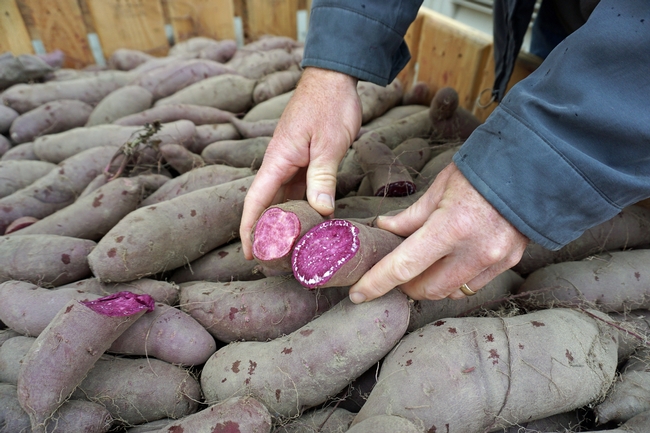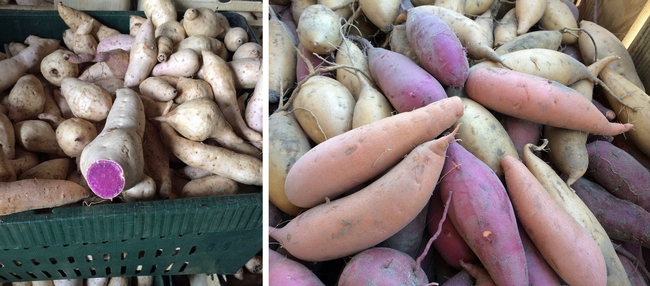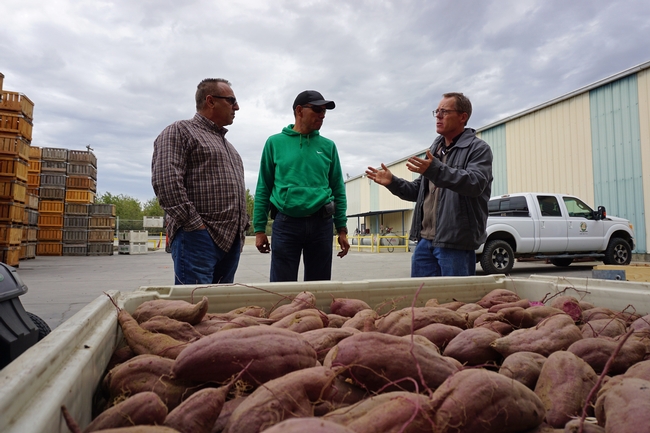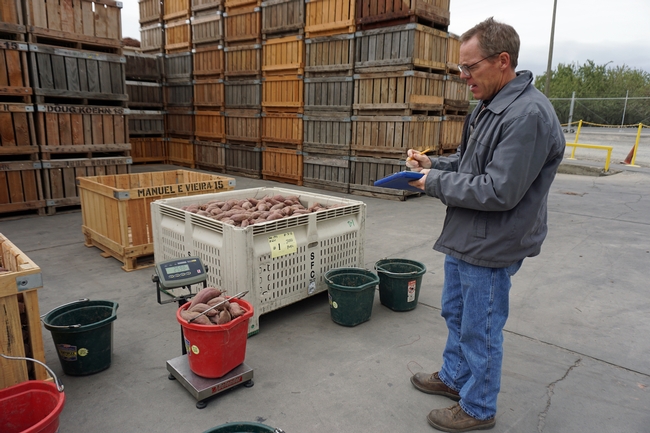Vibrant purple sweet potatoes are a healthful Thanksgiving surprise
Candied sweet potatoes – dripping with butter, brown sugar and pecans – or a casserole of mashed sweet potatoes smothered with toasted marshmallows are common sides on the Thanksgiving table. These rich dishes belie the true nature of sweet potatoes, which are nutrient packed, low-glycemic root vegetables that can be a part of a healthy diet year round.
Research by UC Cooperative Extension advisor Scott Stoddard is aimed at making sweet potatoes an even more healthful and attractive food. Stoddard is working with sweet potato growers in Merced County to see if sweet potatoes with dusky purple skin and vibrant purple flesh, called purple/purples, can be grown by more farmers in California. The unusual color and health benefits command a higher price, opening a potentially profitable niche market.
“Purple flesh sweet potatoes have beta-carotene, like the more common orange varieties, plus anthocyanins,” Stoddard said. “It's like eating a handful of blueberries with your sweet potato.”
California is a significant producer of sweet potatoes. About 80 percent of the California crop – 16,000 acres – is grown in Merced County, on farms ranging from 5 acres up to several thousand acres. In 2015, the crop's value in Merced County was $195 million. About 1,000 acres are grown in Kern County and 2,000 acres in Stanislaus County. These locations have the sandy and sandy-loam soils ideal for sweet potatoes to develop their distinctive shape and smooth skin.
Sweet potatoes with purple flesh are not common, but they have been around for quite some time. They are the main type of sweet potato grown in Hawaii, for example. Several years ago, growers in Stokes County, N.C., selected a particularly beautiful and tasty cultivar, naming it the Stokes Sweet Potato and marketing nationwide with Frieda's Specialty Produce. In California, A. V. Thomas Produce in Livingston acquired an exclusive agreement with the company to grow and market Stokes purple/purple sweet potatoes.
“The number of acres of Stokes has really expanded in just a few years,” Stoddard said. "There is a lot of consumer interest in purple-fleshed sweet potatoes."
That doesn't close the door on purple/purples for California's other growers interested in the niche. Stoddard conducts field trials in cooperation with local farmers that include purple/purples. In one trial, 50 types of sweet potatoes of many different colors are being grown to determine whether they have key characteristics needed for local production. From there, he selects a limited number to grow in replicated trials, to determine their potential to produce a high yield, store well, and develop good size, shape, color and flavor. Of these, only one purple/purple made it into the replicated trial.
“In some purple/purples, the flavor can be off, or bitter,” Stoddard said. “We get rid of those right away.”
One of the cultivars in Stoddard's study, which goes by the experimental code number L-14-15-P, was bred in 2014 by Don La Bonte, a plant breeder at Louisiana State University, Baton Rouge. The potato has some good attributes, but lacks the uniform deep purple color of the Stokes variety.
“Unfortunately, it's probably not good enough to displace Stokes,” Stoddard said. “It's a good start, but we have to continue screening purple/purples to find a variety that offers disease resistance, good yield, and consistent deep purple flesh color."
Good eats
Sweet potatoes can be eaten raw or cooked. To eat raw, simply peel, cut into sticks and serve with low-fat ranch dressing or apple sauce for dipping. Grate fresh, uncooked sweet potatoes and add to burritos or tacos or sprinkle on salads for a sweet, nutritious crunch.
Cooked sweet potatoes can be eaten for breakfast, lunch or dinner, skin and all, plain or with a small pat of butter.
Microwaving is a great way to quickly prepare the vegetable. Wash potatoes and pat dry. Prick skin with a knife in 2 to 3 places. Cook on high for 5 minutes. Turn over. Then cook for another 5 minutes, more or less.
UC Cooperative Extension's sweet potato expert Scott Stoddard says he prefers his sweet potatoes baked.
“Baked is way better,” he said. “Baking gives time to convert the starch to maltose.”
Sweet potatoes are mostly starch, but have a special enzyme that breaks down starch into maltose when cooking. Slower cooking in the oven provides time for the conversion, imparting a subtly sweet caramelized flavor.
To bake, preheat the oven to 400 degrees. Line the lower oven rack with foil, then prick sweet potatoes with a fork and place directly on the middle oven rack, above the rack with foil. Bake 45 minutes for sweet potatoes 2 to 3 inches in diameter.






Posted by Joe on December 10, 2017 at 9:38 PM